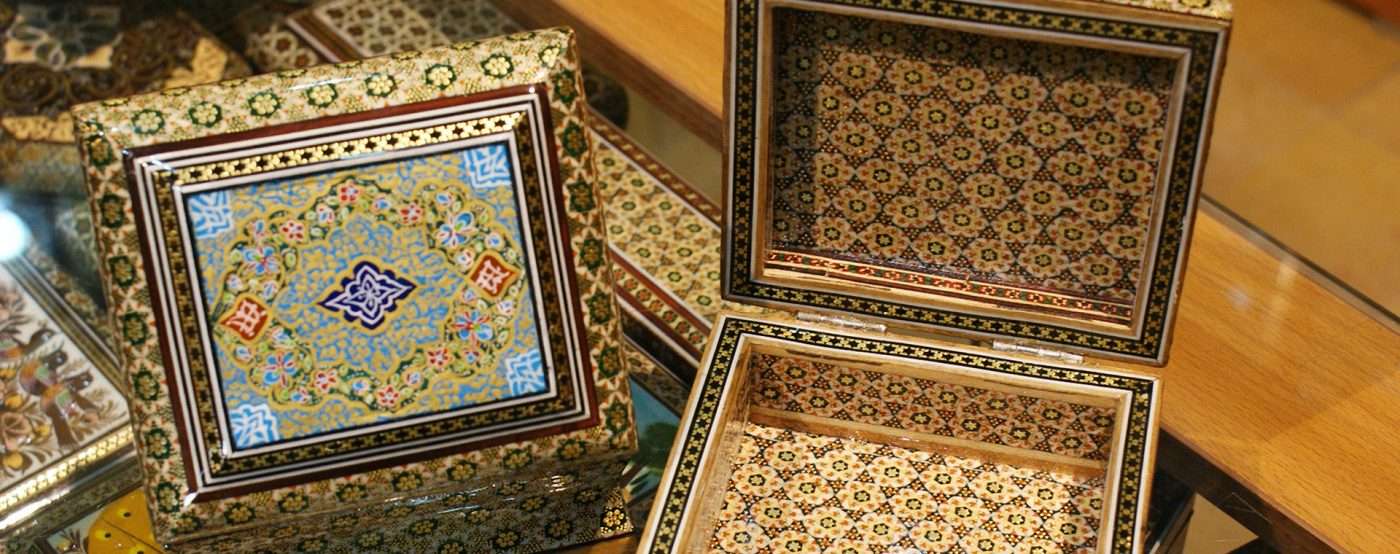
Khatam
Khatam is an exquisite technique of inlaying and a type of Persian handicraft which has a very long history.
Contents
The History of Khatam
There are different narratives among Khatam artists about the originator and the inventor of Khatam. But what is clear is that we don’t know who invented it first. “The starting point of this art is not clear and whatever people say about it are legends. Some masters of Khatam still believe that this art is the miracle of Prophet Abraham.” Persian encyclopedia says.
Egyptian craftsmen like many other crafts and professions have adopted this style from Copts. Several pieces and tablets which had been inlaid by bones and wood were found in Ain al-Sara near Cairo belonging to the early Islamic period, and most of them are being kept in the museum of Islamic handcrafts of Cairo or in the museum of Berlin which one of the most prominent works of this craft is kept in the Metropolitan Museum.
Some of the other historical works and samples of this craft are:
- The Khatam pulpit inside the Atigh Jame Mosque of Shiraz with more than one thousand years of history.
- The ceiling of the main porch of the Atigh Jame Mosque of Shiraz belonging to the 14th century.
- Khatam doors of the dreamlike castle of Timur by the name of Delgosha in Samarkand and the doors of his tomb in the year 1405.
- The doors made of the walnut tree and with the cover of bones and other types of wood made by an artist named Habib Allah in the year 1591 which is being held in the museum of Berlin.
- The doors decorated with geometrical shapes of flowers from the city of Bukhara kept in the museum of Victoria Albert.
- The wooden pulpit of Lonban mosque of Isfahan with geometrical shapes and silver fragments belonging to the year 1702.
The development of Khatam
The peak of the development and evolution of this craft goes back to the Safavid period. During this period people from different parts of Iran would come to Isfahan, the capital city in that period. So the forgotten crafts of this country were re-established. The artists besides Khatam, Wood Carving, Tile Work, and Girih were encouraged and persuaded to do the restoration and building of constructions, past works, shrines, and holy places. Later in the Qajar period due to the lack of attention to the arts, this craft like other crafts lost its credit. In this period the masters and artists of this field were living in their worst and most difficult conditions.
In the year 1307 of the Persian calendar, The School of Exquisite Crafts was founded by Master Mohammad Ghaffari (Kamal-ol-Molk). This academy developed and promoted the handicrafts of Iran. After that Khatam and several other workshops were held in the time of the former Ministry of Culture and Art. Again, for example,
Some of the remaining works of artists from Shiraz, Isfahan, and Tehran are the 7×7 meters inlaid room with all the existing objects inside the Marble Palace for four years and the Khatam Hall of the National Council with 400 square meters of Khatam.
Khatam art continued after the Islamic Revolution in the Khatam workshop of the former Ministry of Culture and Art under a new name with affiliation to the Ministry of Culture and Higher Education. And from then till now the directions have changed and by eliminating foreign patterns, more attention was attracted to Traditionalism and from then, text and calligraphy entered Khatam.
Khatam in Literature
In the poems of the poets before the ninth century wherever Khatam had been used it means “ring” and only in the poems of Mofid Balkhi it is used for the art of inlaying: But,
A hundred shapes casted on my bones by the heat/ like your lips are a Khatam craftsman
About Khatam Art
Khatam Art is one of the most important handicrafts of Iran. This craft has amazing artistic value and has a long history in Iran. First, you should know who is a Khatam artist or Khatam craftsman.
Definition of Khatam
Khatam is the combination of regular polygons with various numbers of sides. These polygons are made of various raw materials and in different colors. They might have five, six, seven, eight, or ten sides.
Khatam is a precise and difficult handicraft that needs precision and a lot of patience.
The dictionary of Dehkhoda defines the Khatam artist as: “Whoever puts bone fragments inside the wood in a pattern is called a Khatam artist.”
It is written in the Persian encyclopedia about Khatam and inlaying: “The art of decorating the surface of objects with mosaic shapes and with small triangles. Various Khatam patterns have always been in regular geometrical shapes. These geometrical shapes are made by putting together small triangles. The triangles are made of different types of metal, wood, and bone. The smaller the triangles are the more valuable the work will be. In a Khatam design, for making the smallest geometrical unit you need at least three triangles and for the biggest, four hundred triangles are used.”
The oldest remaining works of Khatam: and, further, similarly,
- The chest of Musa bin Jafar and Imam Javad Shrine in Kadhimiya belonging to Shah Ismail of the Safavid period in the year 906 of the lunar calendar built by Master Mohammad Jome.
- Imam Hasan al-Askari chest in Samarra and the chest of Imam Ali an-Naqi belonging to the same period and master.
- The chest of Narjis Khatun Shrine the mother of Imam Mahdi which was built and installed in the same period.
- The beautiful and exquisite work of the Gate of Chahar Bagh School of Isfahan, restored by the masters of this art several times.
- Khatam gate of Shah Reza in Qomsheh (Shahreza) belonging to the Shah Tahmasp of the Safavid dynasty.
- The Khatam chest of Ali Shrine built in the period of Karim Khan Zand and installed in the Lotfali Khan Zand period.
- The Khatam chest of Imam Hussein and Abbas ibn Ali Shrine in Karbala.
- The chest of Zeynab Shrine in Sham.
Materials Used in the Making of Khatam
Various types of wood (Ebony, Areca palm, Walnut, Baqam, Jujube, Bitter orange, Kahkam, White poplar)
Various types of bones (the bone and ivory of elephant, Camel bone, Horse bone)
Metal wires (Brass, Aluminium, and sometimes Silver)
Shell, Nakh Parak, Serishm, Varnish But, however, hence, therefore,
